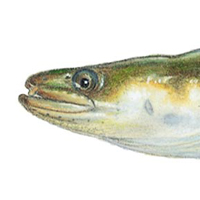American eel
Scientific name: Anguilla rostrata



Cover photos credit: JB Dawson (left), Jason Mortlock (middle), and Joseph R. Tomelleri (right)
Status
Endangered
“Endangered” means the species lives in the wild in Ontario but is facing imminent extinction or extirpation.
Date added to the Species at Risk in Ontario List
The American Eel was already assessed as Endangered when the Endangered Species Act took effect in 2008.
What it looks like
The American Eel is a type of fish with a long, snake-like body and fins that extend along its back, around the tail and along its underside.
It has thick lips with a lower jaw that is slightly longer than its upper jaw, making it look like it has an underbite.
Juveniles are yellowish-green or brown. Adults are grey with a white or cream belly.
Adult females may reach over a metre in length while males reach less than 40 centimetres.
Where it lives
Over the course of its life, the American Eel can be found in both salt and fresh water.
In fact, some scientists consider the American Eel to have the broadest diversity of habitats of any fish species in the world.
Where it’s been found in Ontario
The American Eel starts life in the Sargasso Sea in the North Atlantic Ocean and migrates along the east coast of North America.
In Canada, it is found in fresh water and salt water areas that are accessible from the Atlantic Ocean.
This area extends from Niagara Falls in the Great Lakes up to the mid-Labrador coast.
In Ontario, American Eels can be found as far inland as Algonquin Park. Once the eels mature (10-25 years) they return to the Sargasso Sea to spawn.
What threatens it
Dams and other in-water barriers can prevent access to feeding and spawning areas; this is known as fragmentation.
Hydro-electric turbines also kill American Eels that try to pass through the turbines during their downstream spawning migration.
Invasive species and chemical contaminants may also pose a threat.
Fishing had an impact on the American Eel, although fishing is no longer allowed in Ontario.
Climate change may also pose a threat as changes to the Gulf Stream patterns could interfere with migration.
Action we are taking
Endangered Species and their general habitat are automatically protected
Recovery strategy
A recovery strategy advises the ministry on ways to ensure healthy numbers of the species return to Ontario.
Read the executive summary (November 22, 2013)
Read the recovery strategy (November 22, 2013)
Habitat protection
General Habitat Protection - June 30, 2013
What you can do
Report a Sighting
- The Ministry of Natural Resources and Forestry tracks species at risk such as the American Eel. Report a sighting of an endangered animal or plant to the Natural Heritage Information Centre. Photographs with specific locations or mapping coordinates are always helpful.
- Contact your local Ministry of Natural Resources and Forestry office for more information about programs such as CFWIP (Community Fisheries and Wildlife Improvement Program).
Volunteer
- Volunteer with your local nature club or provincial park to participate in surveys or stewardship work focused on species at risk.
Be a good steward
- Private land owners have a very important role to play in species recovery. You may be eligible for stewardship programs that support the protection and recovery of species at risk and their habitats.
Report illegal activity
- Report any illegal activity related to plants and wildlife to
1-877-TIP-SMNR (847-7667) .
Quick facts
- American Eels were a highly prized food source for Aboriginal people living near the upper St. Lawrence and Lake Ontario, especially during the winter months and when travelling.
- Until the early 1990s, the American Eel was one of the top three species making up the commercial fishing harvest from Lake Ontario. Since then, the number of young American Eels returning to Lake Ontario through the upper St. Lawrence River has declined drastically. Ontario closed the commercial and recreational American Eel fisheries in 2004 and 2005.
- The American Eel is the only fish in North America that is “catadromous”, which means they are born in the ocean, mature in freshwater, then return to the ocean to spawn.
- American Eels can absorb oxygen through their skin as well as through their gills, allowing them to travel briefly over wet grass or mud. This is useful when migrating since eels may have to move around barriers.
- Eels can cover their bodies with a mucous layer which makes them almost impossible to hold and gives them the well-earned description “slippery as an eel”.